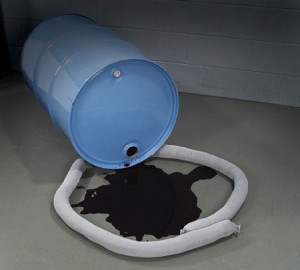THINK – Assess the Situation
Always put SAFETY FIRST! From the moment a spill occurs and throughout the response, determine the risks that may affect human health, the environement and property. If possible, identify the material spilled and try to determine how much was spilled. Spill safety is critical!
PROTECT – Use Personal Protective Equipment (PPE)
Choose the appropriate PPE to safetly respond to the spill. Consult Material Safety Data Sheets (MSDS) and literature from the chemical and PPE manufacturers for the best recommendations. If you are uncertain of the danger, or you are not propertly trained, call the designated responders or use the highest level of personal protection. Remember SAFETY FIRST!
CONTAIN – Prevent The Spill From Spreading
Limit the spill area by blocking, diverting or confining the spill using absorbents or absorbent socks. Block the flow of liquid before it reaches and contaminates a water source. Look around for drains.
PLUG – Stop The Spill At Its Source
As soon as the spill is contained, eliminate the problem to prevent more liquid from being spilled. This may be as simple to turning a container upright or plugging a hole in a damaged drum or tank. Transfer liquids from the damaged container to a new one.
CLEAN – Evaluate the Incident and Implement Clean Up
Once the spill is contained and the leak has been stopped, reassess the incident and develop a plan of action forSpill Clean Up. Absorbents are commonly used to clean up liquid spills. Absorbent pads, pillows, socks or granular absorbents should be placed throughout the spill area to absorb the remainder of the chemical or oil.
DISPOSE & REPORT – Follow All Regulations
Unused absorbents are not hazardous, but once they are saturated with oils, solvents, etc, they may be considered hazardous waste. Dispose of all soiled absorbents according to local, state and ferdaral guidelines. Also complete all notification and paperwork as required for reporting all spill incidents. Failure to do so can result in severe penalties.
DECONTAMINATE – Return The Site To Its Original State
Decontaminate the site, personnel and equipment by removing or neutralizing the hazardous materials that have accumulated during the spill. The may involve removing and disposing of contaminated media, such as soil, that was exposed during the spill incident. An effective decontamination area ensure the health and safety of emergency responders.
